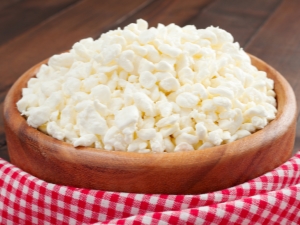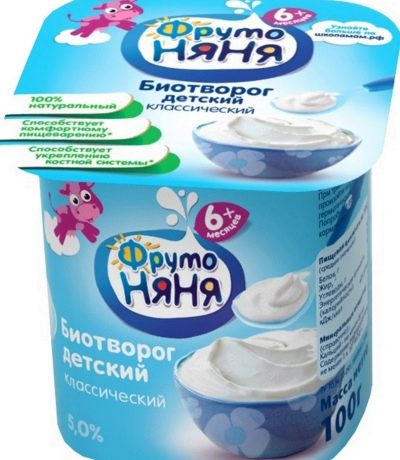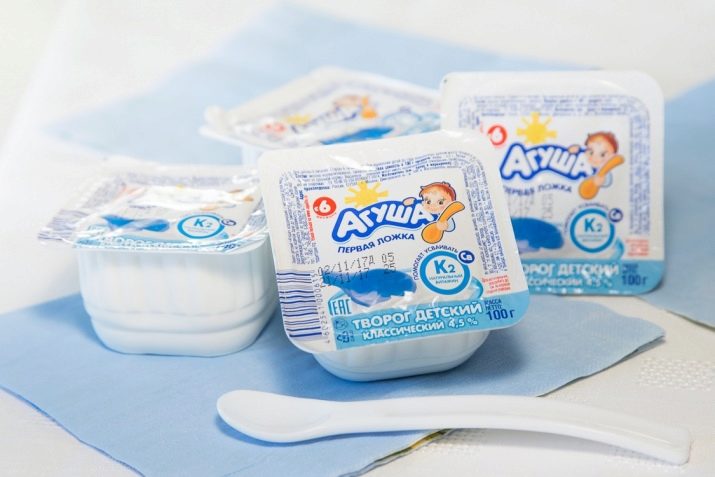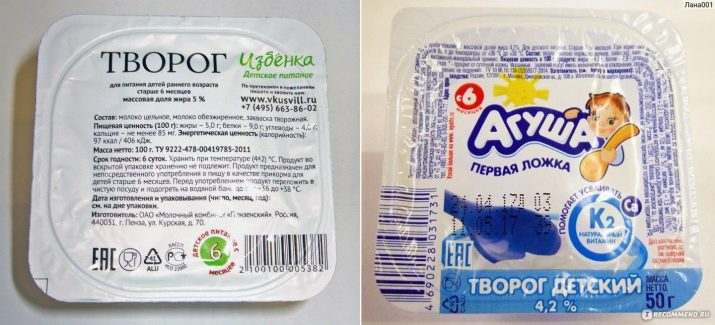At what age can cottage cheese be given to a child and how to introduce it to the complementary foods?

The proper functioning of a child’s body, as well as the active development of the skeletal and muscular system, directly depends on the well-being of calcium in the body, the necessary vitamins and beneficial trace elements. For everyone, it is no secret that all these substances are abundantly contained in dairy products. The most useful of these products is cottage cheese. Unfortunately, many parents do not know at what age they can begin to feed their crumbs with this delicious delicacy. Today's article will help to deal with this issue in detail.
Beneficial features
First of all, cottage cheese is the main source of calcium, necessary for the proper development of the skeletal system. This reason alone is enough to include this product as a must-have in the baby’s diet. As well as cottage cheese easily absorbed by the child's body, without delivering the crumb any discomfort in the stomach.
This dairy product is the main key to the harmonious work of the gastrointestinal tract, and probiotics, which are in its composition, serve as the main protector of the intestine against harmful microorganisms and facilitate easy digestion of food.
In addition, the curd product has a lot of useful properties that are beneficial for the proper functioning of the whole organism:
- due to the high protein content, cottage cheese stimulates the proper development of the muscular, skeletal and internal systems of the body as a whole;
- from this product, the body receives vitamin A, which provides the baby with good eyesight even in a twilight setting;
- cottage cheese contains a rich amount of vitamin D, without which the correct development of the musculoskeletal system is impossible;
- This dairy product perfectly strengthens the nervous, cardiovascular and immune systems.
All the above properties apply only to the natural product. Analogs prepared from low-quality raw materials, will not bring absolutely no benefit, but, on the contrary, can harm the immature body of the baby.
Possible harm
Despite the fact that the curd has on the body a lot of positive properties, in some cases it can significantly harm the crumbs. Contraindications to this product relate by and large to children with the following physical indications:
- kidney disease;
- broken chair;
- stomach problems.
Due to the high protein content, consuming this product can negatively affect children's kidneys. And also today, experts increasingly find such a deviation in children as lactose intolerance. In this case, the cottage cheese can cause a strong blow to the health of the baby. A child may experience bloating, abdominal pain and even an allergic reaction. That is why it is necessary to introduce cottage cheese into the food gradually and gently, while keeping an eye on the health of the crumbs. If everything is good - the amount of the product can be safely increased, but if there are any health problems, you should immediately abandon the curd.
But also do not rush when choosing a product in the store. Overdue cottage cheese can harm even the most healthy children's body. If it is wrong to introduce a tender baby, 6-month-old baby, baby at 9 months or 1 year old, then diarrhea is possible.
The optimal age to start feeding
Experts allow the introduction of cottage cheese in supplements already in the sixth month of a baby’s life. If the baby is breastfed, you can start feeding with the eighth month, and if he eats artificial mixtures, then you can add cottage cheese to the diet as early as the seventh month of life.
The presence of the following health problems allows you to begin feeding the curd dairy product already in the sixth month of life:
- weight loss;
- the presence of rickets or anemia;
- artificial feeding from the moment of birth.
Before acquainting a baby with a curd product, it is recommended to consult a pediatrician.
Which product is better to choose?
To date, the range of baby food is very large, but not all cottage cheese products are suitable for a weak children's body.
When choosing cottage cheese for your crumb, you must follow only one rule: the product must be made of high-quality natural raw materials. And also special attention should be paid to the indicator of fat content. It should range from 3.8% to 10%. There are products with a higher rate of fat, but to begin with the body should be accustomed to a lighter curd.
A purchase of cottage cheese, which does not contain dyes and preservatives, is recommended for a child under one year of age. A kid older than one year old is allowed to add cottage cheese products with the addition of natural fruits.
Children's cottage cheese is divided into four varieties, each of which is suitable for certain physical indicators of the baby.
- Lactic. Suitable for children suffering from lack of physical activity, overweight or diabetes.
- Creamy. Due to the high mass fraction of fat, such cottage cheese is recommended for children who are problematically gaining weight.
- Combined. The composition of this product contains vegetable and animal fats. As well as the combined cottage cheese is rich in polysaturated fatty acids, which stimulates brain performance.
- With filler. Such products have a whole abundance of flavors: vegetable, fruit, berry. Such a delicacy can feed even the most fastidious toddler.
And you should also choose cottage cheese, produced by the leading brands in the baby food market. The quality of the brands listed below is always at the highest level, and also trustworthy millions of moms.
- "Agusha". Cottage cheese is made exclusively from natural milk.
- "Theme". It is made from natural milk with the addition of a special starter. The curd of this line is enriched with many useful probiotics and prebiotics.
- "Fruto Nanny". Made from natural milk and leaven.
- "Prostokvashino". The curd is saturated with all the necessary probiotics and is made from 100% natural milk.
That the product was, really, useful and high-quality, and also the crumb to taste, should follow the simple recommendations on the choice of children's cottage cheese.
- Even if there is no specialized curd for children on the shelves, in no case is it recommended to purchase adult cottage cheese for the baby, since it can cause significant harm to the immature organism.
- Choosing a cottage cheese for feeding, you must carefully examine the packaging of the product. It must necessarily indicate the age for which the curd is intended, and the date of its manufacture.
- It is recommended to give preference to products stored in the refrigerator. The product lying on the shelves, quickly deteriorates under the influence of sunlight falling on it.
- An integral attribute of a quality product is the integrity and tightness of the package.
- An important role is played by the brand, which produced children's products.
- The composition of high-quality cottage cheese should not be present GMOs, artificial colors and preservatives. If the product is flavored, then they must be natural.
Children's curds can be prepared independently at home.
Despite the quality and popularity of the above products, most moms hold the opinion that the best product is the one that was cooked with their own hands. In this case, you must strictly adhere to the recipe, as well as with the utmost seriousness to the choice of raw materials from which the curd will actually be prepared.
In addition, the cooking process should be guided by three simple rules.
- When making a curd from milk, you should make a choice in favor of a drink with a high percentage of fat content.
- The amount of the product that is supposed to be in the end is very easy to calculate: from 4 liters of milk you will get a kilogram of finished curd.
- Need to follow the process of cooking. If the composition is overexposed on fire, it will turn out to be tough, and if it is under-contained it is too acidic. It is also important not to forget that homemade children's cottage cheese cannot be brought to a boil.
In the preparation of homemade children's curds nothing complicated. The basis for it can serve as kefir, milk or yogurt.
From milk
For the preparation of this cottage cheese should choose fresh milk with a high percentage of fat.
The first step is to sour milk. To do this, pour it into a saucepan and put in a warm place for about twenty hours. As soon as the product turns sour, you can separate the whey from the curd mass. For this, the composition must be poured into a saucepan and sent to a water bath. After half an hour, the whole curd mass will float to the surface. It remains to strain it with cheesecloth and colander, let the resulting curd drain from the whey residues.
From kefir
This recipe is easier than the previous one, because the process of its preparation will take much less time. Kefir is suitable for this absolutely any fat content.
Pour the kefir into the pan and place in a water bath. The fire should be moderate. As soon as the serum begins to depart, the composition must be mixed and removed from the heat. Strain it, and carefully squeeze with gauze.
The method of cooking curd from yogurt is identical to the previous one.
How to enter into the diet?
The introduction of cottage cheese in the bait begins with small portions. Getting a baby with this dairy product begins with half a teaspoon. The cheese at the same time must be pasty or thoroughly crushed. After a day, the procedure can be repeated. Each time the portion should be doubled. In the period from 6 to 7 months, the daily rate should be 15 grams, and from 7 to 8 - 30 grams. By the year of life the baby normally should consume 50 grams of cottage cheese product.
In two weeks the feeding is allowed to fill the curd with kefir, cream or yogurt. Once the body is fully adapted to the new product, the curd mass will be allowed to decorate with grated cookies or chopped fruit.
It is very important to give the crumbs this high-calorie products at the right time. It is best to do this in the middle of the day, but not later than 17:00. Despite all its useful qualities, cottage cheese has the peculiarity of causing gas formation, which will give your baby discomfort during sleep.
Ideally, children's cottage cheese should be an addition to the main dish: mashed potatoes or porridge. And you should drink it with plenty of liquid.
Sour milk products are an essential helper of the body in the proper development and functioning, which is why the curd must be present in the baby's diet. However, it is not necessary to force the child to feed the cottage cheese product. If the baby refuses cottage cheese, it means that the body does not need a dairy product at the moment.
If the child is very picky about food, or he simply does not like the sour taste or the smell of cottage cheese, mommy can take advantage of little tricks.
- You can add to the curd mass a couple of drops of juice that the kid loves the most.
- You can diversify the taste of the product with the help of various berries, fruits, honey or regular sugar (however, you should not overdo it with the latter).
- You can mix cottage cheese with grated banana or applesauce. From such a delicacy will not refuse any peanut.
Cottage cheese is a most precious product with a variety of elements necessary for the proper development of the baby.In order for the toddler's organism to receive all the useful substances in full, parents should seriously and responsibly approach the choice of a cottage cheese for complementary foods, and also begin the acquaintance of the crumbs with this new treat for them. This tasty and healthy product must be present in the diet of each child.
About the age at which you can give cottage cheese to a child, see the following video.


































